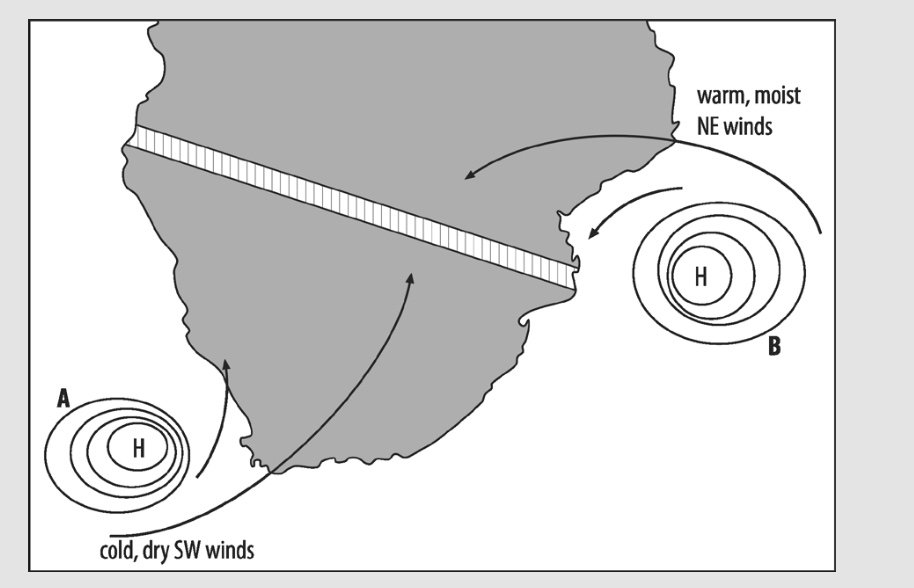Geography Grade 12 Climatology Notes with Questions and Answers Welcome, geography enthusiasts, to a fascinating journey through the intricate world of Climatology. As Grade 12 students, you are on the brink of mastering the complexities of weather patterns, atmospheric phenomena, and the delicate balance that sustains our planet. In this blog post, we’ll delve into essential Climatology notes, explore challenging questions, and provide insightful answers to help you solidify your understanding.
Understanding Climatology:
Climatology is the branch of geography that focuses on the long-term study of weather conditions and atmospheric patterns in a particular region. To grasp the nuances of this field, let’s break down key concepts:
- Atmospheric Circulation:
- Notes: Learn about the Hadley, Ferrel, and Polar cells, and how they influence global wind patterns.
- Question: Explain the impact of Coriolis effect on wind direction in different hemispheres.
- Climate Classifications:
- Notes: Understand the Köppen climate classification system, which categorizes climates based on temperature and precipitation.
- Question: Compare and contrast the characteristics of tropical rainforests and tundras using the Köppen classification.
- Factors Influencing Climate:
- Notes: Explore the role of latitude, altitude, proximity to water bodies, and ocean currents in shaping regional climates.
- Question: Analyze how the El Niño and La Niña phenomena affect global climate patterns.
- Climate Change:
- Notes: Investigate the causes and consequences of climate change, including the greenhouse effect and rising sea levels.
- Question: Propose sustainable measures to mitigate the impact of climate change on vulnerable regions.
DON’T MISS: How to Pass Geography Grade 12 NSC With Distinction
Challenging Questions and In-depth Answers:
- Question: Describe the relationship between climate change and extreme weather events.
- Answer: Climate change intensifies extreme weather events by altering temperature and precipitation patterns. This leads to more frequent and severe events such as hurricanes, droughts, and heatwaves.
- Question: How does the presence of mountain ranges influence the climate on the windward and leeward sides?
- Answer: Windward sides of mountains experience orographic rainfall, leading to lush vegetation. In contrast, leeward sides, in the rain shadow, are often dry due to descending air masses.
- Question: Discuss the impact of urbanization on local climates.
- Answer: Urban heat islands form as cities absorb and retain heat. This can lead to higher temperatures, altered precipitation patterns, and increased air pollution in urban areas.
Climatology Grade 12 Notes Pdf Download
List of popular questions in Geography Grade 12 Climatology

- Identify: (a) high-pressure cells A and B (b) the season.
- Give the reason for the difference in moisture content of the two winds. (2)
- What is the name for the band of low pressure that stretches over the interior and along which the thunderstorms form? (1)
- Explain why thunderstorms and rain occur along the band. (2)
- On which side of the band of low pressure do the line thunderstorms form – the eastern or western side? (1)
- Suggest two negative impacts line thunderstorms have on farming. (2)
- Classify the rain from a line thunderstorm as frontal, convection or orographic.
Answers
- (a)A = South Atlantic High. B = South Indian High 3 (2) b) summer 3 (1)
- The air mass that forms over the warm Mozambique/Agulhas Current 3 of the
Indian Ocean holds more moisture than the
air mass that forms over the cold Benguela Current 3 of the Atlantic Ocean. (2) - moisture trough 3 (1)
- Warm, moist air is forced to rise fast and high 3. There is extensive cooling and condensation 3. (2)
- eastern side 3 (1)
- Any two: They bring rain, but heavy rain and hail can cause flooding 3, soil erosion
3, and crop and livestock damage 3.
Lightning causes fires 3. (2) - convection